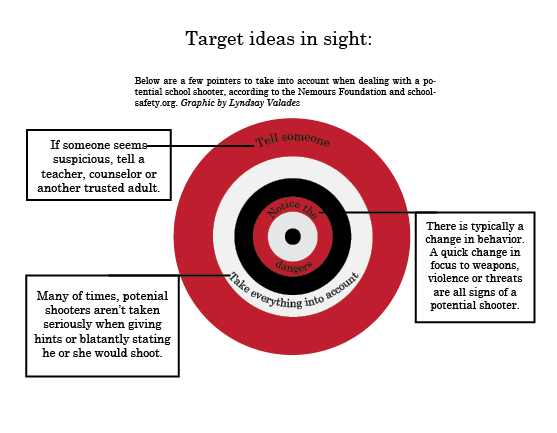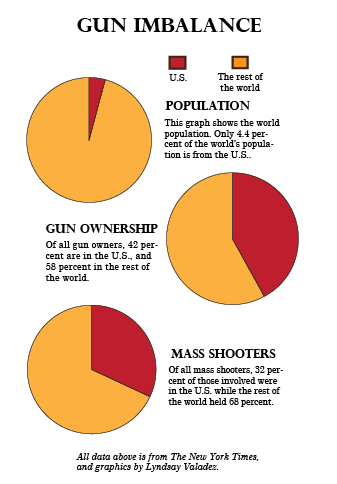Looking down the barrel
Accessibility of guns poses threat to adolescents

Here are just a few pointers to keep in mind in order to become more aware of the possibility of school intruders and shooters.
January 26, 2018
THE DANGERS THAT COME ALONG WITH FIREARMS
The ringing of a telephone at 9 a.m. woke Briana Underwood from her sleep. She picked up the phone and heard the voices of her friends on the other line. Seconds later, she screamed.
Her parents came running. Soon, they learned that her best friend, Fred Stout, had been murdered in a church parking lot.
“It was everything I could do to just get my clothes and my shoes on as fast as I could to … drive to the church, just to see it for myself,” Underwood said.
Stout’s murder occurred two days before Christmas in 1997, when he and Underwood were both juniors at SHS. His death prompted her to become a guidance counselor at the same school, as he gave her the passion and motivation to help students that experienced situations similar to hers. Nearly twenty years after he died, a similar situation occurred. Underwood witnessed the aftermath of the murder of another SHS student, Joshua Luttrell.
“I didn’t know Josh personally, but it did hit home,” Underwood said, “knowing he has friends and his friends’ lives are forever going to be changed over one split second.”
Stout and Luttrell were victims of gun violence. 15-year-old Luttrell was shot by a fellow student, while Stout was shot by a young adult. Their deaths were two out of the nearly 1,300 child deaths that occur every year in the U.S. due to firearms, according to a study in the medical journal “Pediatrics.” This makes guns the third-leading cause of death for U.S. children, who can often find them within their homes or come across them illegally.
An anonymous student, who says she has teenage friends who own guns, says it’s easy for minors to obtain firearms, especially from their families. While there are several reasons that students may possess a firearm, the student says that sometimes guns can be used for protection for students who deal drugs. These guns, according to the student, can be accessed illegally from others outside of the family.
“There’s older people that would jump quickly to buy students the guns,” the student said.
This only adds to the possibility of gun violence at the school level. Last semester, a former student arrived at the SHS parking lot entrance with a gun in the car. Officer Ashley Rose, upon noticing that the driver didn’t have a pass, approached the vehicle and saw the handgun. He then drew his own weapon, forced the driver to exit the car and handcuffed him. The entire event, according to Principal Brian Knight, took no more than 60 seconds.
Knight says the driver not being able to get on the property was a result of the “proactive” procedures that are in place at SHS. All of the outside doors, for example, are locked and checked every period to make sure they aren’t propped open. However, Knight says it’s a “challenge” to keep the building safe because there are lots of entrances to maintain, and students stick pencils in the doors to keep them open.
“We need some help on the student end to understand that, ‘Hey, when I prop that door open, yes, it’s easier for me to get back in, but anyone can walk in,’” Knight said.
Similarly, English teacher Heather Todero is concerned about students leaving doors open as it could affect the safety of the school.
If someone were to bring a firearm to school, Todero believes an effective way to protect students, faculty and staff is to arm certain teachers before the event. Although she doesn’t think every teacher in the building should have one, she advocates that there should be some trained and licensed teachers who know how to operate a weapon.
“I think the only reason we would need (a teacher to use a weapon) is for the possibility of a gun threat,” Todero said. “Do I ever think that something like that would happen? I would pray not. I would hope not.”
However, guns can be too easily accessible by teenagers, according to sophomore Megan Frank. She does believe, though, that as long as people know the safety of a gun and its threat to human life, they should be allowed to obtain one.
Frank and her family have a total of four guns. Their rifle and handgun, kept in the house, are stored in a safe, with the clips and bullets kept in “parts and pieces” so they are not dangerous to children. The availability of a gun makes Frank feel safer, because she says her dad could protect her and her family if an intruder were to enter her house.
Despite the fact that she feels safer with a gun, Frank acknowledges that teenagers and gun violence is a problem. In Indiana, it’s illegal for minors to have guns unless they receive it from their guardians, but Frank says it’s up to families to keep firearms away from their children.
“Teenagers shouldn’t be able to carry a gun, because it’s illegal anyway,” Frank said. “The only reason why somebody should have a gun is for hunting or if you are under attack.”
Graphic by Lyndsay Valadez
This compilation of pie charts compares the United States to the rest of the world in reference to guns and gun violence.
WILL CURRENT GUN LAWS KEEP STUDENTS SAFE?
He is a hunter, gun enthusiast and the Police Chief of University of Indianapolis. Yet, defying the stereotype, David Selby is a believer in stronger gun control laws.
“A lot of people are just not scrupulous, and they’re selling guns to people without doing any paperwork on them,” Selby said. “It’s really easy for kids to get guns.”
At the time the Second Amendment was written, Selby says, people were using flintlocks, a type of ignition system that is no longer used for firearms. These weapons were less accurate and required more time to reload ammunition. Now, people are firing with much more advanced weapons, and he maintains the gun laws should be changed accordingly. An alteration in those laws, he says, can be put into practice without being too restrictive of Second Amendment rights.
Out of all industrialized countries, the U.S. has the highest levels of gun related deaths, according to the American Association of Child and Adolescent Psychiatry, or AACAP. Also in the U.S., semi-automatic weapons, which are sometimes classified as assault weapons, are not illegal.
“I think people should absolutely have the right to bear arms and hunt and things like that, but I don’t think they need advanced assault weapons,” Selby said. “Those are designed just to kill people.”
In Indiana, it’s not required for guns or their owners to be registered, according to the National Rifle Association of America, or NRA.
Junior Aaron Gallagher believes that Indiana and U.S. laws don’t necessarily need to be changed, but the process of obtaining a gun does. He thinks it should be done in the form of stronger background checks because firearms aren’t a bad thing. He, like Todero, claims guns could potentially be helpful in a dangerous situation in which someone might need protection, like during a school shooting.
However, Gallagher adds that a gun’s intended purpose can often be forgotten by gun owners and that they should be monitored. He thinks that it’s important to remind them to “cut to reality again” because they often lose sight that guns are meant for protecting people.
“(Gun owners) originally have this idea of helping people, but then it turns into this violent flash where they get angry, and they turn and use it against someone,” Gallagher said.
HOW TO PREPARE FOR A POTENTIAL THREAT OR ATTACK
Gallagher has friends who are gun owners, and he says he is worried that they could potentially become dangerous while trying to protect themselves. Therefore, he has “serious talks” with them about calming down.
“I think people should take time to talk to somebody that owns a gun and make sure that they’re doing all right,” Gallagher said. “If you ever have this idea that someone’s thinking about using their gun against someone, you should definitely try to see if you can talk to them. If not, call an authority figure.”
Agreeing about a lack of touch with reality is officer Schanel Manek of the Southport Police Department, who says teenagers lose their tie with reality because video games desensitize violence for them. She suggests that in playing these games, they immerse themselves in a “twilight factor zone” where there are no ramifications for their actions. She says it’s important that parents explain gun safety to children.
“(In video games) everyone is shooting and killing people,” Manek said. “That’s fantasy, and (potentially violent teenagers) take that fantasy and make it reality. The parents need to learn how to parent and tell the kid how to distinguish the two.”
While there are preventative measures to take before gun violence occurs, guidance counselor Briana Underwood says that if a student notices someone with a gun or talking about bringing a gun to school, an adult should be notified immediately so that precautions can be taken.
“We want to make sure that everyone is safe, even possibly the person that has the gun,” Underwood said. “We want to make sure that everyone is safe in the situation and that it wouldn’t escalate.”




Christy Bell • Dec 22, 2023 at 9:02 am
Thinking of you, Fred ?